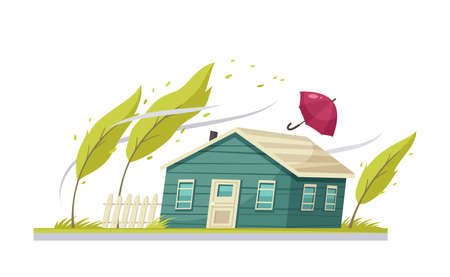Introduction to Natural Disaster Insurance in the U.S.
Natural disasters such as hurricanes, wildfires, earthquakes, and floods are a growing concern for homeowners and renters across the United States. With climate change driving more frequent and severe weather events, securing proper insurance coverage has become increasingly important. While standard homeowners or renters policies may cover some forms of damage, many natural disasters require additional or separate insurance to ensure full protection. This necessity is not uniform nationwide; rather, the type and level of coverage needed can vary significantly from state to state due to differing regional risks and local regulations.
For both homeowners and renters, understanding natural disaster insurance options is essential. Coverage not only protects personal property but also provides financial stability and peace of mind during unexpected events. The relevance of natural disaster insurance is heightened in states more prone to specific hazards—for example, tornadoes in the Midwest, wildfires in California, hurricanes along the Gulf Coast, or flooding in the Southeast. As a result, what may be considered adequate protection in one state could be insufficient in another.
The table below provides an overview of common natural disasters and their prevalence by region:
| Disaster Type | Most Affected Regions/States |
|---|---|
| Hurricanes | Florida, Texas, Louisiana, North Carolina |
| Earthquakes | California, Alaska, Pacific Northwest |
| Wildfires | California, Colorado, Oregon |
| Tornadoes | Kansas, Oklahoma, Missouri, Texas (“Tornado Alley”) |
| Floods | Lousiana, Florida, Mississippi, New Jersey |
This diversity underscores why it’s crucial for property owners and tenants alike to understand both what their existing insurance covers and where additional protection may be required. In the following sections, we will explore these state-by-state differences in greater detail to help you make informed decisions about your natural disaster insurance needs.
2. Types of Natural Disaster Coverage
When it comes to protecting your home or rental property, understanding the types of insurance coverage available for natural disasters is essential—especially since options and requirements can vary widely from state to state. Here’s an overview of the most common policies homeowners and renters consider in the United States, along with how they are typically structured:
Flood Insurance
Standard homeowners or renters insurance policies do not cover flood damage. Flood insurance must be purchased separately, usually through the National Flood Insurance Program (NFIP) or from private insurers. Coverage limits, availability, and pricing depend heavily on state regulations and whether your property is in a high-risk flood zone.
Key Features of Flood Insurance
| Coverage Type | Description |
|---|---|
| Building Property | Covers the physical structure and foundation of the home |
| Personal Property | Covers belongings such as furniture, electronics, and clothing |
| Availability | Available nationwide, but required in high-risk areas (state-dependent) |
Earthquake Insurance
This policy is not included in standard homeowners or renters insurance and must be purchased separately, especially in earthquake-prone states like California, Washington, and Alaska. Earthquake insurance covers repairs to your home and sometimes personal property damaged by seismic events.
Typical Structure of Earthquake Policies
- High deductibles compared to other disaster policies
- Covers structural damage and often additional living expenses if you’re displaced
- Availability varies; some states have dedicated earthquake authorities (e.g., California Earthquake Authority)
Hurricane Insurance
The need for hurricane insurance is most pronounced in coastal states like Florida, Texas, and Louisiana. While windstorm damage may be included in standard policies in some regions, many insurers require separate hurricane or windstorm riders in high-risk areas.
Components of Hurricane Coverage
- Windstorm Coverage: Protects against damage from hurricane winds; may require a separate deductible or policy depending on the state.
- Flood Damage: Not covered under hurricane insurance—must be purchased as a separate flood policy.
- State Regulations: Dictate deductible amounts and whether coverage is mandatory based on proximity to the coast.
Wildfire Insurance
This type of coverage has become increasingly important in Western states like California and Colorado. While fire damage is usually covered under standard homeowners policies, some high-risk areas require special endorsements or excess coverage due to frequent wildfires.
Main Points About Wildfire Protection
- Covers fire-related structural damage and loss of personal property
- Certain states allow insurers to exclude wildfire coverage or impose higher premiums/deductibles in high-risk zones
- Add-on endorsements may be necessary depending on local regulations and insurer offerings
Summary Table: Common Natural Disaster Insurance Types by State Prevalence
| Insurance Type | Common States/Regions Required or Recommended |
|---|---|
| Flood Insurance | Southeast (FL, LA), Gulf Coast, Northeast coastal areas, Midwest floodplains |
| Earthquake Insurance | West Coast (CA, WA, OR), Alaska, central US fault zones (MO) |
| Hurricane/Windstorm Insurance | Southeastern US (FL, TX, NC), Gulf Coast states, Atlantic seaboard states |
| Wildfire Insurance/Endorsements | Western US (CA, CO, AZ), parts of TX and MT with high fire risk zones |
The specifics of what’s covered—and what’s not—can vary significantly based on both your location and your insurer’s policies. Always check your policy details carefully and consult with a licensed agent familiar with your state’s requirements before deciding which natural disaster coverage best suits your needs.

3. Key Differences in State Regulations and Requirements
Natural disaster insurance regulations and requirements for homeowners and renters are not uniform across the United States. Instead, each state sets its own rules, reflecting the region’s unique risk profile and history of disasters. This results in significant variation in what is required, what is available, and how much protection residents can expect.
Insurance Requirements: Mandatory vs. Optional Coverage
Some states with a high frequency of natural disasters have stricter insurance mandates. For example, in California, insurers must offer earthquake coverage as an option to all residential policyholders, but it is not mandatory for homeowners or renters to purchase it. By contrast, in Florida, where hurricanes are common, windstorm insurance is often required by mortgage lenders if the property is located in a designated high-risk area.
Availability of Coverage Across States
The availability of natural disaster insurance also varies widely. In some high-risk areas, private insurers may limit offerings or increase premiums due to frequent claims. To address this, states like Texas and Florida have established state-run insurance pools (e.g., Texas Windstorm Insurance Association) to provide coverage that might otherwise be unavailable on the private market. Meanwhile, in low-risk regions such as Nebraska or Minnesota, standard homeowners and renters policies typically exclude most disaster coverage (like flood or earthquake), but specialty policies are generally available for those who want extra protection.
Comparison Table: State-by-State Examples
| State/Region | Main Disaster Risks | Mandated Coverage? | Availability |
|---|---|---|---|
| California (West Coast) | Earthquake, Wildfire | No (must be offered) | Private & State-Backed Options |
| Florida (Southeast Coast) | Hurricane, Flood | Lender-Required for High-Risk Areas | Private Limited, State Pool Available |
| Tornado Alley (Oklahoma/Kansas) | Tornado, Hailstorm | No Mandate | Widely Available Privately |
| Northeast (New York) | Flooding, Winter Storms | No Mandate (Flood Required by Lenders in Special Zones) | Mainly via Federal NFIP Program |
| Minnesota (Midwest) | Low Risk: Some Flooding/Windstorm | No Mandate | Add-On Policies Optional |
Impact on Homeowners and Renters
This patchwork of regulations means that homeowners and renters need to be aware of their state’s specific requirements and options. For instance, a renter in Louisiana may need to secure separate flood insurance due to frequent hurricanes, while someone renting in Colorado may focus more on wildfire coverage. Understanding these regional differences ensures that individuals can make informed decisions about protecting their property and belongings from local natural hazards.
4. Factors Influencing Insurance Costs and Coverage
When it comes to natural disaster insurance for homeowners and renters, several key factors cause significant differences in costs and coverage across states. Understanding these elements is crucial for anyone seeking the right policy for their property or rental unit.
Geography and Regional Risks
One of the most important determinants is geography. States prone to certain natural disasters—like hurricanes in Florida or wildfires in California—often have higher premiums and more restrictive coverage options. Insurers assess regional risks based on historical data, topography, and proximity to known hazard zones, which directly impacts both eligibility and cost.
Recent Disaster History
The frequency and severity of recent natural disasters also play a major role. If a state has experienced multiple costly events in recent years, insurers may raise premiums or restrict coverage availability to manage their risk exposure. For example, after a series of devastating hurricanes or floods, policies may come with higher deductibles or exclusions in affected regions.
State Legislation and Regulation
Each state sets its own regulations regarding what insurers must offer and how much they can charge. Some states require insurers to provide certain types of disaster coverage (like earthquake insurance in California), while others allow providers more flexibility to exclude high-risk areas or perils. These legislative differences can make a big impact on both the cost and accessibility of natural disaster insurance from one state to another.
Comparison Table: Key Factors by State
| State | Common Disasters | Average Premium Impact | Notable Regulations |
|---|---|---|---|
| California | Earthquake, Wildfire | High (especially wildfire-prone areas) | Mandatory earthquake offer; fire zone mapping |
| Florida | Hurricane, Flood | Very High (coastal properties) | Windstorm deductible rules; Citizens Property Insurance availability |
| Tornado Alley States (e.g., Oklahoma) | Tornado, Hail | Moderate to High (based on storm activity) | No mandatory tornado coverage; limited wind/hail exclusions allowed |
| Northeast States (e.g., New York) | Flood, Winter Storms | Moderate (river/coastal areas higher) | Flood insurance via National Flood Insurance Program (NFIP) |
This complex interplay of geography, recent history, and state-level regulation shapes the landscape of natural disaster insurance in the U.S., making it essential for homeowners and renters to understand their specific states context when shopping for coverage.
5. Challenges for Homeowners vs. Renters
When it comes to securing natural disaster insurance, homeowners and renters face distinctly different challenges depending on which state they live in. These obstacles stem from differences in property ownership, coverage needs, and the availability of specialized policies. Below is an analysis highlighting these unique challenges across the United States.
Coverage Availability and Requirements
| Homeowners | Renters | |
|---|---|---|
| Policy Type | Require both property and contents coverage; need add-ons for disasters like earthquakes or floods | Mainly need contents coverage; building structure covered by landlord’s policy |
| State Regulations | Must navigate state-specific requirements for disaster add-ons (e.g., mandatory flood insurance in some coastal areas) | Lack of state mandates often leads to underinsurance; fewer state-level consumer protections |
| Premium Costs | Higher premiums due to full property value and location risk factors | Generally lower premiums but limited options in high-risk areas |
| Availability of Specialized Policies | Certain states (like California or Florida) offer state-backed or subsidized disaster insurance programs for homeowners | Access may be restricted or non-existent for renters in some states |
State-by-State Variability Impacting Homeowners and Renters
The disparity between homeowners and renters becomes even more pronounced when considering how states regulate and offer natural disaster insurance. For example, while homeowners in Texas might be able to purchase windstorm insurance through a dedicated state pool, renters may not have access to similar programs, leaving their personal property vulnerable. Meanwhile, in places like New York, both groups may struggle with high premiums or limited availability following recent major events.
Key Obstacles for Homeowners:
- Navigating complex policy add-ons (flood, earthquake, wildfire) that vary by state.
- Bearing higher costs due to mandatory coverages in high-risk zones.
- Facing exclusions or limitations based on property location and previous disaster history.
Key Obstacles for Renters:
- Lack of awareness about the need for separate renters’ insurance covering personal belongings.
- Fewer tailored options for disaster protection compared to homeowners.
- Poor access to state-sponsored programs or subsidies that are typically geared toward property owners.
The Bottom Line:
The process of obtaining adequate natural disaster insurance is influenced heavily by both one’s status as a homeowner or renter and the laws of the state in which they reside. State-by-state regulatory environments, differing insurance product offerings, and eligibility criteria create a patchwork landscape where both groups must remain vigilant to ensure they are properly protected against increasingly frequent natural disasters.
6. How to Assess and Purchase the Right Coverage
Choosing the right natural disaster insurance in the U.S. requires understanding the specific risks in your state, comparing insurance providers, and closely reviewing policy terms. Here’s a step-by-step guide for homeowners and renters to make informed decisions.
Evaluate Your State’s Risk Profile
Natural disaster threats vary widely across states. For example, California is prone to earthquakes and wildfires, while Florida faces hurricanes and flooding. Start by identifying the most common risks in your area using resources from your state’s Department of Insurance or FEMA’s hazard maps.
| State | Common Natural Disasters | Recommended Coverage Types |
|---|---|---|
| California | Earthquakes, Wildfires | Earthquake Insurance, Fire Coverage |
| Florida | Hurricanes, Flooding | Windstorm, Flood Insurance |
| Texas | Tornadoes, Flooding, Hailstorms | Wind/Hail, Flood Insurance |
| Oklahoma | Tornadoes, Earthquakes | Windstorm, Earthquake Endorsements |
| Northeast States (e.g., New York) | Winter Storms, Flooding | Flood, Winter Damage Coverage |
Compare Providers and Policy Options
The availability of certain coverages—like flood or earthquake insurance—can vary not only by state but also by provider. Some states have government-backed pools (e.g., California Earthquake Authority), while others rely on private insurers. Use comparison tools provided by your state’s Department of Insurance to assess premiums, coverage limits, deductibles, and customer satisfaction ratings.
Key Considerations When Comparing Policies:
- Coverage Limits: Does the policy cap payouts for certain disasters?
- Deductibles: Are there separate deductibles for wind, hail, flood, or earthquake claims?
- Exclusions: What disasters are explicitly excluded based on your location?
- Add-ons/Endorsements: Can you customize coverage for your specific needs?
- Provider Stability: Is the insurer financially stable and licensed in your state?
Understand State-Level Policy Terms and Regulations
Laws governing insurance can differ greatly by state. For instance, some states mandate flood disclosure when buying property; others have unique windstorm pools or require minimum coverage levels. Review your state’s consumer guides and seek clarification from licensed agents about requirements and recommendations specific to your location.
Helpful Resources by State:
- Your State Department of Insurance website – for regulatory updates and complaint records.
- National Flood Insurance Program (NFIP) – for federally backed flood policies where available.
- FEMA Map Service Center – to check if you are in a high-risk zone that requires special coverage.
- A local independent insurance agent – who understands your area’s unique needs.
This careful assessment will help both homeowners and renters secure the right protection against local natural hazards—and avoid costly gaps in coverage.
7. Summary and Resources
Understanding the differences in natural disaster insurance across states is crucial for both homeowners and renters. Here’s a recap of the key points discussed in this article:
- Coverage Varies by State: Insurance requirements, coverage options, and available policies can differ significantly depending on your location.
- Homeowners vs. Renters: Homeowners typically need to purchase separate policies for disasters like floods and earthquakes, while renters should ensure their personal property is protected and understand landlord responsibilities.
- State Regulations Matter: Each state has its own laws regulating what insurers must offer, deductible levels, and consumer protections.
- Federal Programs Fill Gaps: FEMA, the National Flood Insurance Program (NFIP), and other federal resources provide essential support where private insurance is limited or unavailable.
- Nonprofit Guidance: Organizations such as United Policyholders and local consumer advocacy groups offer valuable advice tailored to regional risks.
Official State & Federal Insurance Resources
| Resource Type | Description | Sample Link |
|---|---|---|
| State Insurance Department | Regulatory authority providing information on approved policies, complaints, and disaster-specific guidance. | Find Your State Department |
| National Flood Insurance Program (NFIP) | The primary source for flood insurance in the U.S., administered by FEMA. | FloodSmart.gov |
| FEMA Disaster Assistance | A hub for federal disaster relief programs and emergency information. | DisasterAssistance.gov |
| United Policyholders | A nonprofit offering consumer guides and tools for disaster preparedness and claims help. | UPHelp.org |
| Red Cross – Disaster Preparedness | Tips, checklists, and local resources for emergency planning. | Red Cross Emergency Prep |
Next Steps for Homeowners and Renters
- Review your current insurance policy to confirm which natural disasters are covered or excluded.
- Contact your state’s insurance department for up-to-date rules and recommendations.
- If you rent, talk to your landlord about their insurance coverage and consider supplemental renters’ insurance if needed.
- Create an emergency plan using nonprofit guidance like the Red Cross or United Policyholders resources above.
- If you live in a high-risk area (such as coastal zones or earthquake-prone regions), consult both state and federal resources to ensure adequate protection.
The landscape of natural disaster insurance is complex but manageable with the right information. Use these curated links to access official guidance tailored to your location, ensuring that you’re protected—no matter where you live in the U.S.


